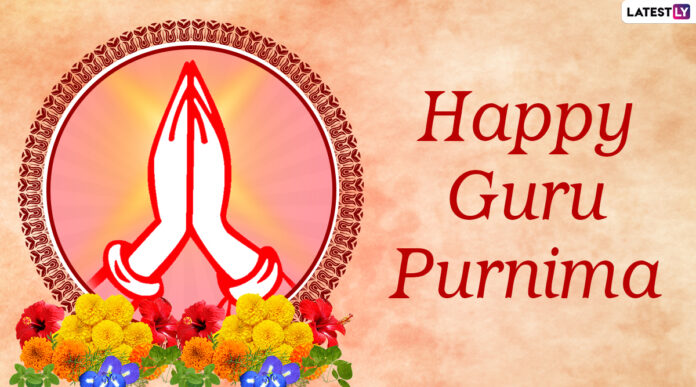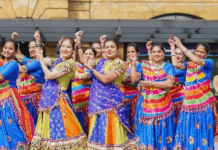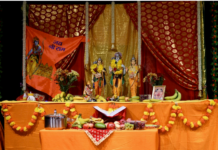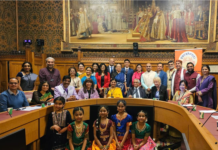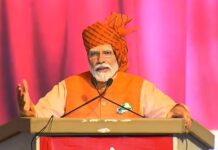Guru Purnima also known as Vyasa Purnima, is traditionally celebrated by Hindus, Sikhs, Jains and Buddhists to revere their spiritual and academic teachers. It is celebrated on Ashada Shukla Purnima (day of full moon) of the Hindu calendar. On this day, disciples express their gratitude towards their teachers by offering puja (worship) or pay respect to their Gurus.
Guru Purnima honours birth of Ved Vyasa, known as one of the most honoured Gurus of the world. Veda Vyasa, structured the four Vedas, composed the epic of the Mahabharata, created 18 Puranas and the vast encyclopaedias of Hindu sacred lore.
The word Guru is derived from two root words in Sanskrit, i.e., Gu (darkness or ignorance) and Ru (remover of the darkness). Therefore, one who leads us from darkness (ignorance) to light (jnana/knowledge) is known as Guru. Guru Purnima is celebrated to show our gratitude to the one who takes us from a life of misery to a life of peace and bliss. Our Guru is our God manifested on earth. He is the one who will help us to be liberated and united with God. In addition to having religious importance, Indian academics celebrate this day by thanking their teachers as well as remembering past teachers and scholars.
Traditionally, Buddh Purnima has been celebrated by Buddhists. It commemorates Gautam Buddha’s first sermon to his first five disciples in Uttar Pradesh’s Sarnath.
Gurus have a special place in the lives of their followers since ancient times. All the holy books Bhagwat Gita, Vedas, Puranas of Hinduism dictate the importance of Gurus and the extraordinary bond between a Guru and his Shishya (disciple). A Sanskrit phrase ‘Mata Pitah Guru Daivam’, says that the first place is reserved for the mother, second for the father, third for Guru and forth for God. Thus, gurus have been given a higher place than Gods in Hindu tradition.
In general, we use the word ‘teacher’ for ‘gurus. But there is difference between teacher and a guru. Sanskrit words for “teacher” are based on their unique abilities & these are 6 phases or called it an evolution of a teacher.
- The teacher who gives you Information is called ADHYAPAK
- The one who imparts knowledge along with Information is called UPADHYAYA
- The one who Imparts skill is called ACHARYA
- The one who is able to give deep insight into a subject is called PANDIT
- The one who has a visionary view on a subject and teaches you to think in that manner is called DHRISHTA
- The one who is able to awaken the wisdom in you, leading you from darkness to light is called GURU
These are 6 Unique abilities of a TEACHER, the word we use in general term.
Which means that teaching journey of a teacher is from ADHYAPAK to GURU and a student Journey is to learn under ADHYAPAK to GURU.
The significance of Guru Purnima is to tell people the importance of gurus in our life. A True guru will always help us in our difficulties. And life is the greatest chapter which really needs a true guru for living it peacefully and happily.
India as VISWA GURU.
Becoming a Vishwa Guru is often regarded as a sign of national desire, and there is nothing wrong with it. Nations, like people, require a national aspiration. And India is capable of pursuing this aspiration. India was Vishwa Guru. Before any conquests, India was sole superpower and a Vishwa Guru. In the 17th century, India, a major player in the global economy, was a major exporter of spices, sugar, textiles, handicrafts, and other goods. It was also one of the first countries to implement an economic model.
In fact, despite of so many invasions and blows to our country, we still have everything: abundance of natural resources, efficient military system, well-developed cities, most beautiful landscape, heavenly climate, very knowledgeable saints, philosophers and teachers and on the top of it people who follows the Dharma.

As we celebrate Azadi Ka Amrit Mahotsav, the 75th anniversary of our Independence, what has been achieved by us is remarkable in many ways. From record agricultural output to advancements in nuclear and space technology, from ensuring affordable healthcare to establishing world-class educational institutions, from ayurveda to biotechnology, from massive steel plants to becoming an IT power and having the world’s third-largest start-up ecosystem, our post-independence journey has been truly impressive. We can’t reject our traditions, but we also can’t stay prisoners of them. India can serve as an example of how we can progress toward modernity and still saves ourselves from Westernization.
Another key message of the Idea of India to be as Viswa guru is to treat the entire world as one family, or Vasudhaiva Kutumbakam. It’s not for nothing that Prime Minister Narendra Modi, in his very first address to the UN General Assembly, questioned why, like the G7 and G20, there couldn’t be a group named G-All to deal with global concerns.
This is what drives India’s desire to be the world’s knowledge provider. The primary theme of the concept of India is that civilisational cultures migrate from the past to the present and to the future. Our vision has been formed by the fundamentals of our philosophy.
 By Anil Kumar@Eshadoot.com
By Anil Kumar@Eshadoot.com

Readers like you, make ESHADOOT work possible. We need your support to deliver quality and positive news about India and Indian diaspora - and to keep it open for everyone. Your support is essential to continue our efforts. Every contribution, however big or small, is so valuable for our future.

